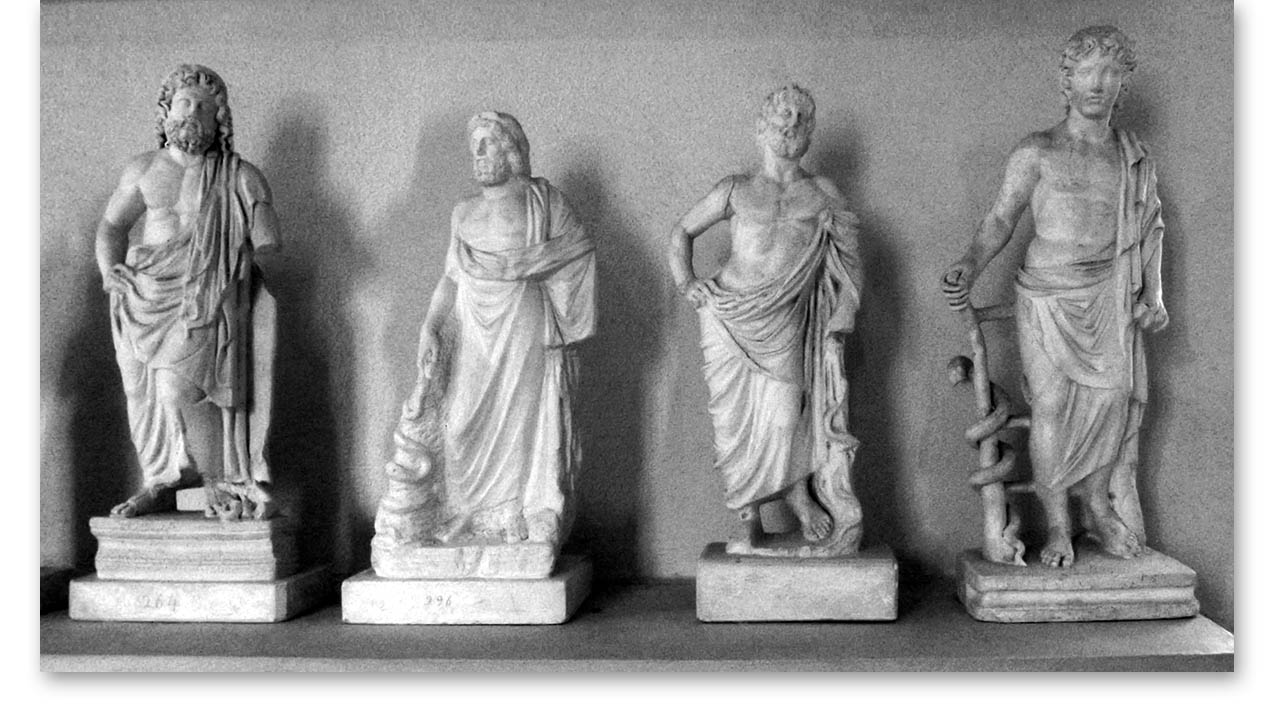ASCLEPIUS: HOW THE CULT DEVELOPED
The cult of Asclepius seems to have arisen from the success of a mortal-physician-turned-god. Asclepius, the son of Apollo and a mortal woman, learned the medical trade in his youth from the centaur Cheiron, and became so adept at healing that eventually Zeus granted him the status of a god. The cult is based on a fantastic beginning, the power of snakes, the use of dreams, and a super-human ability to heal.
Descendants and Students
The descendants of Asclepius were called Asclepiadae. The knowledge of medicine was regarded as sacred and was transmitted from father to son. In the fifth century BC, the famous physician Hippocrates began to train students who were not born into medical families, but medical knoweldge continued to be considered sacred. We still possess the famous Hippocratic Oath, sworn to Asclepius and Apollo, in addition to all the other gods, that ancient physicians took when they inherited these medical secrets.
The ancient Hippocratic Oath begins with the invocation...
"I swear by Apollo the Physician and by Asclepius and by Hygieia
and Panacea and by all the gods ..."
A fantastic beginning
When Asclepius was still in the womb, Apollo killed his mother Coronis because she had engaged in an inappropriate sexual union. While Coronis was burning on the funeral pyre, Apollo rescued the baby from her uterus and entrusted it to the centaur Cheiron, who raised the child and taught him the art of healing. Asclepius grew to be a masterful healer, capable of not only preventing death but even of resurrecting the dead.
Untimely Death
Asclepius’s abilities to reverse death brought him to the unkind attention of his grandfather Zeus. Zeus, king of the gods and always anxious to maintain control by limiting the powers of other gods, killed Asclepius with a thunderbolt fashioned by the Cyclopes. Apollo intervened on his son’s behalf and convinced Zeus to bring him back to life. This he did and even raised Asclepius to the ranks of the gods. However, Zeus also forbade Asclepius from ever again returning anyone from death to life.
Asclepius is almost always portrayed holding a walking staff, a symbol of the itinerant nature of ancient physicians, who traveled often from town to town to heal the sick. Around Asclepius's staff curls a snake, whose ability to shed its skin symbolizes a return to health. This staff entwined by a serpent remains the symbol of most medical associations today.
Family
In some traditions, Aclepius was married to Epione and had six daughters and several sons. The names of two of his daughters, Hygieia and Panacea, are evident still today as medical terms, and his whole family was involved in the healing sanctuary at Epidaurus.
Places and Practices
By about 400 BC, the reputation of the cult of Asclepius had grown enormously and pilgrims flocked to his healing sanctuary at Epidaurus to be cured. Visitors who sought healing would first cleanse themselves with water, then make offerings to the god (such as animal sacrifices), and finally would sleep in the holiest part of the sanctuary next to the god’s temple and altar, in the hope of meeting the god in a dream and being cured.
In these dreams, the god practiced procedures ranging from surgery and cautery to the application of drugs and poultices. Some cures involved the use of sacred animals, especially snakes and occasionally dogs and geese, that might lie next to the sick and even lick their wounds.
The cult of Asclepius was one of the most enduring and widespread of any of the cults of classical antiquity. Hundreds of his sanctuaries dotted Italy, Greece, the eastern Mediterranean, and north Africa. The cult began at Epidaurus, we think, and spread to new sites by individuals transporting one or more of the god’s sacred serpents to a new temples.
The Roman poet Ovid tells of the departure of Asclepius in the form of a snake from Epidaurus in order to journey all the way to Rome and establish a sanctuary there that would save the Romans from a plague:
“The god nodded, and shook his crest, confirming his favour, by hissing three times in succession, with his flickering tongue. Then he glided down the gleaming steps, and turning his head backwards, gazed at the ancient altars he was abandoning, and saluted his accustomed house, and the temple where he had lived".
From there the vast serpent slid over the flower-strewn ground, flexing his body, and made his way through the city centre to the harbour, protected by its curved embankment.
He halted there, and, appearing to dismiss the dutiful throng, with a calm expression, settled his body down in the Ausonian ship. It felt the divine burden, and the keel sank under the god’s weight. The Romans were joyful, and, sacrificing a bull on the shore, they loosed the twisted cables of their wreath-crowned ship.
A gentle breeze drove the vessel: the god arching skyward, rested his neck heavily on the curving sternpost, and gazed at the dark blue waters.
With gentle breezes he reached Italy.”
(Ovid, Metamorphoses 15; translated by A.S. Kline,
http://www.poetryintranslation.com/PITBR/Latin/Metamorph15.htm#anchor_Toc64106013)
ASCLEPIUS: THE CULT
Contacts
John Goodinson Artist/designer/illustrator
Christina Jansen Photographer
Phenomenists Internet Agency/ISP
The British Museum London England
The Acropolis Museum Athens Greece
Maxon Software Developer
Our affiliate partner
Theran Press is the academic publishing imprint of Silver Goat Media. Theran is dedicated to authentic partnerships with its academic associates, to the high quality design of scholarly books, and to elite standards of peer review. Theran seeks to liberate intellectuals from the confines of traditional academic publishing. Theran authors are authorities and revolutionaries in their respective fields.
Theran encourages new models for generating and distributing art, science, and knowledge. For our creatives. For our communities. For our world.
Our Hosting Partner
Phenomenists Internet (ISP) was founded in 2000, to meet a growing demand for cost-effective and
reactive internet services, Phenomenists have provided the hosting services and support for all our online projects since 2008. John Goodinson is a member of the creative team and has worked with Phenomenists since 2008.
